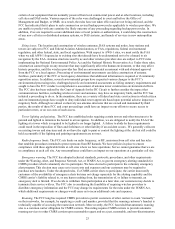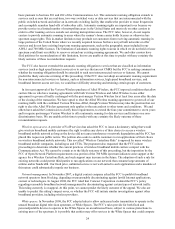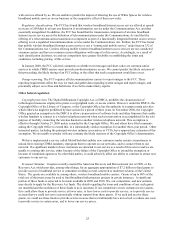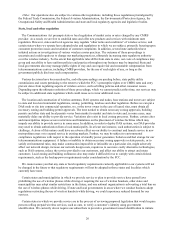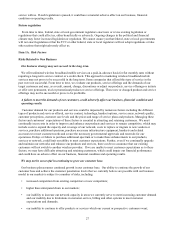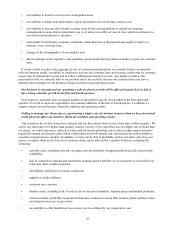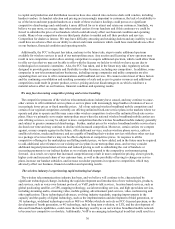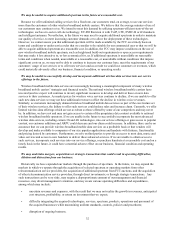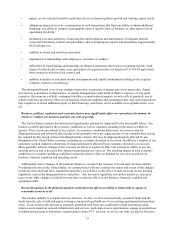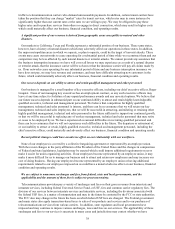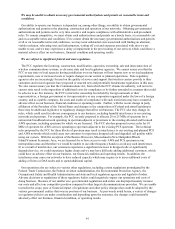Metro PCS 2008 Annual Report Download - page 40
Download and view the complete annual report
Please find page 40 of the 2008 Metro PCS annual report below. You can navigate through the pages in the report by either clicking on the pages listed below, or by using the keyword search tool below to find specific information within the annual report.31
decrease in demand for switched telephone services, such as those we currently provide. The resulting technological
development of WiFi or WiMax enabled handsets permitting customers to communicate using voice and data
services with their handset using this VoIP technology in any area equipped with a wireless Internet connection, or
hot spot, would potentially allow more carriers to offer larger bundles of minutes while retaining low prices and the
ability to offer attractive roaming rates. The number of hot spots in the U.S. is growing rapidly, with some major
cities and urban areas approaching universal coverage. Further, the development of new equipment, such as
femtocells, could allow our competitors to offer increased usage without increased cost thus reducing our cost
advantage.
Thus, our continued success will depend, in part, on our ability to anticipate or adapt to these and future
technological changes and to offer, on a timely basis, services that meet customer demands. For us to keep pace
with these technological changes and remain competitive, we must continue to make significant capital expenditures
to our networks and/or acquire additional spectrum. Customer acceptance of the services that we offer will
continually be affected by technology-based differences in our product and service offerings and those offered by
our competitors. We cannot assure you that we will obtain access to new technology, such as LTE, on a timely
basis, on satisfactory terms, or that we will have adequate spectrum, or be able to acquire additional spectrum, to
offer new services or implement new technologies. If we do not offer these services, we may have difficulty
attracting and retaining customers. Further, we cannot predict the effect of technological changes on our business.
We also cannot be certain that the choices we make regarding technology and new service offerings will prove to be
successful in the market place or will achieve their intended results. All of these factors could have a material
adverse effect on our business, financial condition and operating results.
We are dependent on certain network technology improvements which may not occur, or may be materially
delayed.
Most national wireless broadband mobile carriers have greater spectrum capacity than we do that can be used to
support 3G and 4G services. These national wireless broadband mobile carriers are currently investing substantial
capital to deploy the necessary equipment to deliver 3G enhanced services and have invested in additional spectrum
to deliver 4G services. Two of our national wireless broadband mobile competitors acquired a significant portion of
the 700 MHz spectrum recently auctioned by the FCC. This 700 MHz spectrum is considered by some industry
experts to be particularly desirable due to its propagation characteristics. The national wireless broadband mobile
carriers in many instances on average have more spectrum in each of the metropolitan areas in which we operate, or
plan to operate, than we or Royal Street do. Our limited spectrum may require us to secure more cell sites to
provide equivalent service (including data services based on EV-DO or LTE technology), spend greater capital
compared to our competitors, deploy more expensive network equipment, such as six-sector antennas, EV-DO
Revision A with VoIP or LTE, deploy equipment sooner than our competitors, require us to use DAS systems or
make us more dependent on improvements in handsets, such as EVRC-B or 4G capable handsets. There can be no
assurance that the additional technology improvements will be developed by our existing infrastructure provider,
such improvements will be delivered when needed at cost-effective prices, that such technology improvements will
deliver our projected network efficiency improvements, or that we can secure adequate tower sites or additional
spectrum or have access to DAS systems.
If projected or anticipated technology improvements are not achieved, or are not achieved in the timeframes in
which we need such improvements, or at the costs we anticipate or can afford, or are not developed by our existing
suppliers, we may not have adequate spectrum in certain metropolitan areas, which may limit our ability to increase
our customer base, may inhibit our ability to achieve additional economies of scale, may limit our ability to offer
new services offered by our competitors, may require us to spend considerably more capital and incur more
operating expenses than our competitors with more spectrum, and may force us to purchase additional spectrum at a
potentially material cost. If our network infrastructure vendor does not supply such improvements, or materially
delays the delivery of such improvements, and other network equipment manufacturers are able to develop such
technology, we may be at a material competitive disadvantage to our competitors and we may be required to change
network infrastructure vendors, which could have a material adverse effect on our business, financial condition and
operating results.




